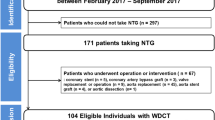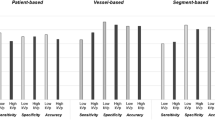Abstract
Purpose
We evaluated low-contrast injection protocols for coronary computed tomography angiography (CTA) using a 64-detector scanner and the test bolus technique.
Materials and methods
We randomly assigned 60 patients undergoing coronary CTA to one of two contrast material (CM) injection protocols. For the lowcontrast dose protocol (Plow), the patients received injections of iohexol-350 [0.7 ml/kg body weight (BW)] during 9 s, and the test-bolus technique was used. Under the conventional protocol (Pconv), they received iohexol-350 (1.0 ml/kg BW) during 15 s, and bolus tracking was used. We compared the protocols for attenuation values in the ascending aorta and coronary arteries and for the amount of CM required.
Results
There was no significant difference in the mean CT attenuation of the ascending aorta and coronary arteries between the Plow and Pconv groups. The amount of CM was significantly less with Plow than with Pconv [49.7 ± 6.4 ml (main bolus: 39.7 ± 6.4 ml) vs. 57.0 ± 10.1 ml, P < 0.01].
Conclusion
With 64-detector CTA of the heart, the low-dose and short-injection-duration protocol with the test-injection technique provides vessel attenuation comparable to that obtained with the standard-dose protocol with the bolus-tracking technique.
Similar content being viewed by others
References
Ehara M, Surmely JF, Kawai M, Katoh O, Matsubara T, Terashima M, et al. Diagnostic accuracy of 64-slice computed tomography for detecting angiographically significant coronary artery stenosis in an unselected consecutive patient population: comparison with conventional invasive angiography. Circ J 2006;70:564–571.
Nikolaou K, Knez A, Rist C, Wintersperger BJ, Leber A, Johnson T, et al. Accuracy of 64-MDCT in the diagnosis of ischemic heart disease. AJR Am J Roentgenol 2006;187:111–117.
Pannu HK, Jacobs JE, Lai S, Fishman EK. Coronary CT angiography with 64-MDCT: assessment of vessel visibility. AJR Am J Roentgenol 2006;187:119–126.
Cademartiri F, Mollet NR, Lemos PA, Saia F, Midiri M, de Feyter PJ, et al. Higher intracoronary attenuation improves diagnostic accuracy in MDCT coronary angiography. AJR Am J Roentgenol 2006;187:W430–W433.
Cademartiri F, Maffei E, Palumbo AA, Malago R, La Grutta L, Meiijboom WB, et al. Influence of intra-coronary enhancement on diagnostic accuracy with 64-slice CT coronary angiography. Eur Radiol 2008;18:576–583.
Nakaura T, Awai K, Yauaga Y, Nakayama Y, Oda S, Hatemura M, et al. Contrast injection protocols for coronary computed tomography angiography using a 64-detector scanner: comparison between patient weight-adjusted- and fixed iodinedose protocols. Invest Radiol 2008;43:512–519.
Bae KT, Seeck BA, Hildebolt CF, Tao C, Zhu F, Kanematsu M, et al. Contrast enhancement in cardiovascular MDCT: effect of body weight, height, body surface area, body mass index, and obesity. AJR Am J Roentgenol 2008;190:777–784.
Yamamuro M, Tadamura E, Kanao S, Wu YW, Tambara K, Komeda M, et al. Coronary angiography by 64-detector row computed tomography using low dose of contrast material with saline chaser: influence of total injection volume on vessel attenuation. J Comput Assist Tomogr 2007;31:272–280.
Sandstede JJ, Tschammler A, Beer M, Vogelsang C, Wittenberg G, Hahn D. Optimization of automatic bolus tracking for timing of the arterial phase of helical liver CT. Eur Radiol 2001;11:1396–1400.
Cademartiri F, Nieman K, van der Lugt A, Raaijmakers RH, Mollet N, Pattynama PM, et al. Intravenous contrast material administration at 16-detector row helical CT coronary angiography: test bolus versus bolus-tracking technique. Radiology 2004;233:817–823.
Josephson SA, Dillon WP, Smith WS. Incidence of contrast nephropathy from cerebral CT angiography and CT perfusion imaging. Neurology 2005;64:1805–1806.
Becker CR, Hong C, Knez A, Leber A, Bruening R, Schoepf UJ, et al. Optimal contrast application for cardiac 4-detectorrow computed tomography. Invest Radiol 2003;38:690–694.
Cademartiri F, Mollet NR, van der Lugt A, McFadden EP, Stijnen T, de Feyter PJ, et al. Intravenous contrast material administration at helical 16-detector row CT coronary angiography: effect of iodine concentration on vascular attenuation. Radiology 2005;236:661–665.
Fei X, Du X, Yang Q, Shen Y, Li P, Liao J, et al. 64-MDCT coronary angiography: phantom study of effects of vascular attenuation on detection of coronary stenosis. AJR Am J Roentgenol 2008;191:43–49.
Bae KT. Peak contrast enhancement in CT and MR angiography: when does it occur and why? Pharmacokinetic study in a porcine model. Radiology 2003;227:809–816.
Awai K, Nakayama Y, Nakaura T, Yanaga Y, Tamura Y, Hatemura M, et al. Prediction of aortic peak enhancement in monophasic contrast injection protocols at multidetector CT: phantom and patient studies. Radiat Med 2007;25:14–21.
Bae KT, Heiken JP, Brink JA. Aortic and hepatic contrast medium enhancement at CT. Part II. Effect of reduced cardiac output in a porcine model. Radiology 1998;207:657–662.
Sivit CJ, Taylor GA, Bulas DI, Kushner DC, Potter BM, Eichelberger MR. Posttraumatic shock in children: CT findings associated with hemodynamic instability. Radiology 1992;182:723–726.
Fleischmann D, Rubin GD, Bankier AA, Hittmair K. Improved uniformity of aortic enhancement with customized contrast medium injection protocols at CT angiography. Radiology 2000;214:363–371.
Bae KT, Tran HQ, Heiken JP. Uniform vascular contrast enhancement and reduced contrast medium volume achieved by using exponentially decelerated contrast material injection method. Radiology 2004;231:732–736.
Utsunomiya D, Awai K, Sakamoto T, Nishiharu T, Urata J, Taniguchi A, et al. Cardiac 16-MDCT for anatomic and functional analysis: assessment of a biphasic contrast injection protocol. AJR Am J Roentgenol 2006;187:638–644.
Lee CH, Goo JM, Bae KT, Lee HJ, Kim KG, Chun EJ, et al. CTA contrast enhancement of the aorta and pulmonary artery: the effect of saline chase injected at two different rates in a canine experimental model. Invest Radiol 2007;42:486–490.
Fleischmann D. Use of high concentration contrast media: principles and rationale—vascular district. Eur J Radiol 2003;45(suppl 1):S88–S93.
Author information
Authors and Affiliations
Corresponding author
About this article
Cite this article
Nakaura, T., Awai, K., Yanaga, Y. et al. Low-dose contrast protocol using the test bolus technique for 64-detector computed tomography coronary angiography. Jpn J Radiol 29, 457–465 (2011). https://doi.org/10.1007/s11604-011-0579-5
Received:
Accepted:
Published:
Issue Date:
DOI: https://doi.org/10.1007/s11604-011-0579-5




